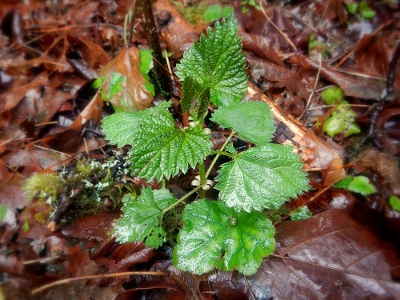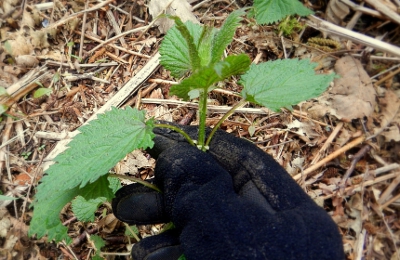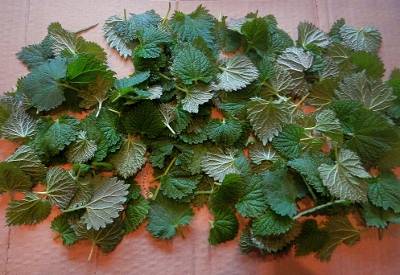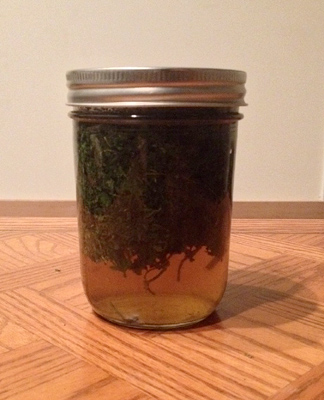Stinging Nettle Tea and Infusions

By Gabe Garms
Stinging nettle tea and infusions are easy to make and have many health benefits!
As a kid, I spent many summers fly fishing along rivers and streams which were often laden with stinging nettle (Urtica dioica). Back then I would curse it endlessly and avoid it at all costs. It's funny because today I purposely seek it out the plant and get ridiculously excited whenever I run into a large stand. That's because I eventually came to the realization that stinging nettle happens to be one of the most nutritious and healing herbs around.
Nutritionally speaking, stinging nettle tea and especially infusions are high in iron, potassium, calcium, manganese and vitamins A, C and D. Medicinally, it both strengthens and heals your kidneys and adrenal glands. Susun Weed, a renowned herbalist, claims that she's never seen any one plant heal the kidneys as well as nettle does. It's also been used by many cultures to treat respiratory ailments, allergies, hypertension, arthritis and skin ailments such as eczema and psoriasis. I even rinse my hair with stinging nettle tea as an alternative to shampoos and my hair has never been healthier.

Spring through early summer is the best time to harvest the plant to make stinging nettle tea and infusions. It is best to harvest before it goes to flower. Once it does (during the middle of summer), it develops gritty particles which can do damage to your urinary tract once ingested. So in this 3-4 month harvesting window that we have, I would recommend getting enough stinging nettle to last you for the entire year. Trust me, you'll thank me later. You should be able to find some near you, but if you're having trouble locating this wonderful plant, look for it in areas that have rich moist soils. Wherever you end up harvesting, make sure that it's an area free from chemical sprays, agricultural run-off, pollution and car exhaust. Also, harvest ethically and don't deplete an entire population. A good rule of thumb to follow is harvest one out of every 20 plants in a specified area.
When I go off on a harvest, I typically bring a bag and a glove along with me. When I find a good patch, I never pull the plant from it's roots. Instead, I grab the upper portion of the plant with my glove hand (see picture above) and pop the tops off. By harvesting with this method I can quickly fill up a bag without killing the plant. This allows the plant to continue to grow and potentially provide me with an additional harvest again in a few weeks. I typically harvest about a half of a standard kitchen sized garbage bag per trip since I don't have enough drying space in my room for any more at one time. I'll make 4-5 of these trips during the harvest window and I've found that this provides me with enough for teas and infusions throughout the year.

Once you've completed your harvest, lay out some paper, a towel or some used cardboard in a cool, dry area and spread your leaves thinly over them. The more surface area that you can create the more quickly the drying process will occur. Also remember to turn the leaves periodically so that mold doesn't begin to grow due to trapped moisture. The leaves will lose their sting after about 24 hours so you'll be able to turn the leaves barehanded shortly after that time frame.
Be More Prepared For Your Next Outdoor Adventure!

Don't leave home without knowing these six essential survival skills. Our free survival mini guide reveals the strategies of:
- Shelter & fire to prevent the number one cause of death
- Obtaining clean water to avoid life-threatening dehydration
- Common wild survival foods and other critical skills!

Once you can no longer feel any moisture in the leaves and they can be easily crushed into small pieces, store them in a jar with a lid. Roughly one garbage bag full of fresh leaves and stems fills a one gallon jar with dried herb. Once dried, the nettle will retain it's potency for up to 18 months so you don't need to be in a rush to consume it.

Now it’s time to make stinging nettle tea and infusions! Before I dive
into the process, let’s make sure you understand the difference between a
tea and an infusion. A tea is a small amount of dried herb that is
steeped in hot water for a period of between 5-15 minutes. An infusion,
on the other hand, uses significantly more of the dried herb and is
steeped for much longer – usually in excess of 4 hours. An infusion -
especially nettle infusions - are much more nourishing and medicinal
than a tea.
Making the infusion:
1. Simply take a quart or pint mason jar and fill it roughly half full of dried nettle.
2. Fill the jar with boiling water almost to the brim and secure the lid onto the jar to prevent the steam from escaping. If you let the steam escape, you'll also lose many of the vitamins and trace elements contained in the infusion as well.
3. Let the jar sit for AT LEAST 4 hours (I typically let it sit overnight).
4. Then, using a sifter or permeable material, filter out the plant material from the liquid and store the infusion in the refrigerator.
Stinging nettle tea and infusions keep for 2-3 days so only make enough for however many cups you're planning per day. If you happen to make too much, you can always use the excess as a hair rinse. You may never use shampoo again. Who knows?
By the way, when you're out foraging, it's important to know how to stay safe in the outdoors, especially if you were to get lost. Right now you can get a free copy of our mini survival guide here, where you'll discover six key strategies for outdoor emergencies, plus often-overlooked survival tips.
More Resources on Stinging Nettle Tea & Infusions:
Related Courses:
Wild Edible & Medicinal Plants Courses at Alderleaf
Disclaimer: This article is for educational purposes only.
It is not intended as a substitute for the advice provided by your
physician or other medical professional. If you have or suspect that
you have a serious health problem, promptly contact your health care
provider. Always consult with a health care practitioner before using
any herbal remedy, especially if pregnant, nursing, or have a medical
condition. Alderleaf Wilderness College, their owners and employees,
shall not be liable for injury, damage, or loss allegedly arising from
the information contained in the articles found on this website.

About the Author: Gabe Garms is passionate about permaculture, ethnobotany, birding, and wilderness survival. He wrote several articles while teaching at Alderleaf. Learn more about Gabe Garms.
Return from Stinging Nettle Tea back to Wild Plants Articles
Is The Essential Wilderness Survival Skills Course Right for You? Take the "Online Survival Training Readiness" Quiz
See for yourself if this eye-opening course is a good fit for you. It takes just a few minutes! Get your Survival Training Readiness Score Now!

Grow Your Outdoor Skills! Get monthly updates on new wilderness skills, upcoming courses, and special opportunities. Join the free Alderleaf eNews and as a welcome gift you'll get a copy of our Mini Survival Guide.

 The Six Keys to Survival: Get a free copy of our survival mini-guide and monthly tips!
The Six Keys to Survival: Get a free copy of our survival mini-guide and monthly tips!
Learn more